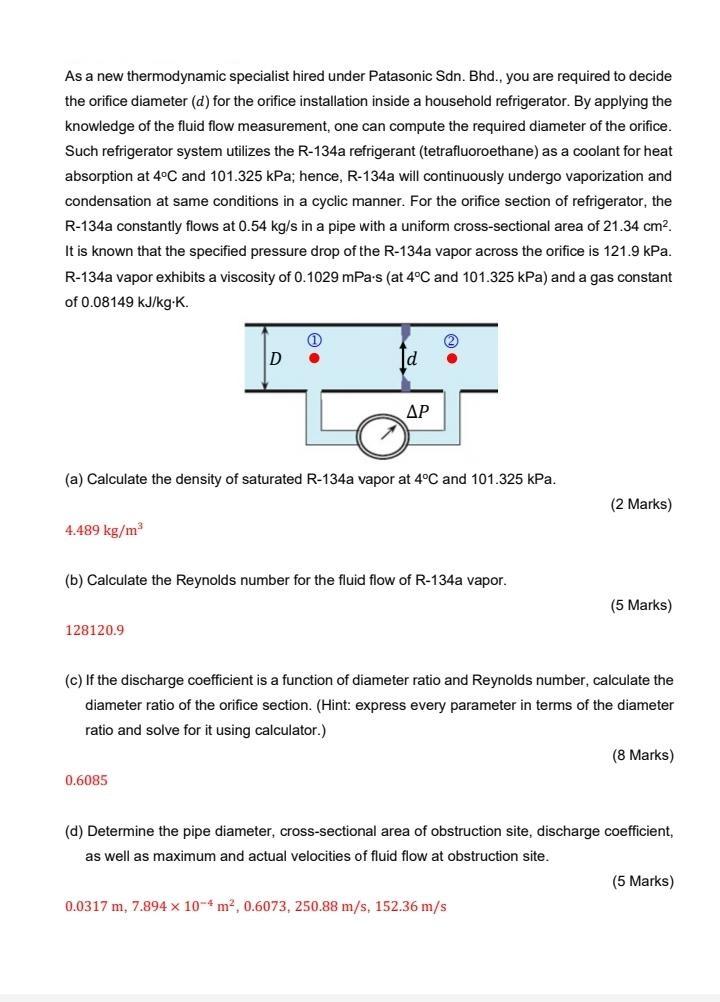Answered step by step
Verified Expert Solution
Question
1 Approved Answer
As a new thermodynamic specialist hired under Patasonic Sdn. Bhd., you are required to decide the orifice diameter (d) for the orifice installation inside

As a new thermodynamic specialist hired under Patasonic Sdn. Bhd., you are required to decide the orifice diameter (d) for the orifice installation inside a household refrigerator. By applying the knowledge of the fluid flow measurement, one can compute the required diameter of the orifice. Such refrigerator system utilizes the R-134a refrigerant (tetrafluoroethane) as a coolant for heat absorption at 4C and 101.325 kPa; hence, R-134a will continuously undergo vaporization and condensation at same conditions in a cyclic manner. For the orifice section of refrigerator, the R-134a constantly flows at 0.54 kg/s in a pipe with a uniform cross-sectional area of 21.34 cm. It is known that the specified pressure drop of the R-134a vapor across the orifice is 121.9 kPa. R-134a vapor exhibits a viscosity of 0.1029 mPa-s (at 4C and 101.325 kPa) and a gas constant of 0.08149 kJ/kg.K. (1) (2) D d (a) Calculate the density of saturated R-134a vapor at 4C and 101.325 kPa. (2 Marks) 4.489 kg/m (b) Calculate the Reynolds number for the fluid flow of R-134a vapor. (5 Marks) 128120.9 (c) If the discharge coefficient is a function of diameter ratio and Reynolds number, calculate the diameter ratio of the orifice section. (Hint: express every parameter in terms of the diameter ratio and solve for it using calculator.) (8 Marks) 0.6085 (d) Determine the pipe diameter, cross-sectional area of obstruction site, discharge coefficient, as well as maximum and actual velocities of fluid flow at obstruction site. (5 Marks) 0.0317 m, 7.894 x 10-4 m, 0.6073, 250.88 m/s, 152.36 m/s As a new thermodynamic specialist hired under Patasonic Sdn. Bhd., you are required to decide the orifice diameter (d) for the orifice installation inside a household refrigerator. By applying the knowledge of the fluid flow measurement, one can compute the required diameter of the orifice. Such refrigerator system utilizes the R-134a refrigerant (tetrafluoroethane) as a coolant for heat absorption at 4C and 101.325 kPa; hence, R-134a will continuously undergo vaporization and condensation at same conditions in a cyclic manner. For the orifice section of refrigerator, the R-134a constantly flows at 0.54 kg/s in a pipe with a uniform cross-sectional area of 21.34 cm. It is known that the specified pressure drop of the R-134a vapor across the orifice is 121.9 kPa. R-134a vapor exhibits a viscosity of 0.1029 mPa-s (at 4C and 101.325 kPa) and a gas constant of 0.08149 kJ/kg.K. (1) (2) D d (a) Calculate the density of saturated R-134a vapor at 4C and 101.325 kPa. (2 Marks) 4.489 kg/m (b) Calculate the Reynolds number for the fluid flow of R-134a vapor. (5 Marks) 128120.9 (c) If the discharge coefficient is a function of diameter ratio and Reynolds number, calculate the diameter ratio of the orifice section. (Hint: express every parameter in terms of the diameter ratio and solve for it using calculator.) (8 Marks) 0.6085 (d) Determine the pipe diameter, cross-sectional area of obstruction site, discharge coefficient, as well as maximum and actual velocities of fluid flow at obstruction site. (5 Marks) 0.0317 m, 7.894 x 10-4 m, 0.6073, 250.88 m/s, 152.36 m/s
Step by Step Solution
★★★★★
3.31 Rating (163 Votes )
There are 3 Steps involved in it
Step: 1
Date Solution a Given that at 4C and 101325 kPa R 008 149 T...
Get Instant Access to Expert-Tailored Solutions
See step-by-step solutions with expert insights and AI powered tools for academic success
Step: 2

Step: 3

Ace Your Homework with AI
Get the answers you need in no time with our AI-driven, step-by-step assistance
Get Started


